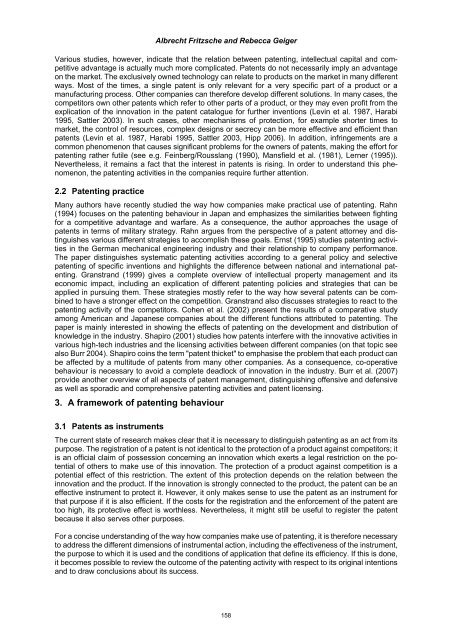Proceedings of the 3rd European Conference on Intellectual Capital
Proceedings of the 3rd European Conference on Intellectual Capital
Proceedings of the 3rd European Conference on Intellectual Capital
Create successful ePaper yourself
Turn your PDF publications into a flip-book with our unique Google optimized e-Paper software.
Albrecht Fritzsche and Rebecca Geiger<br />
Various studies, however, indicate that <str<strong>on</strong>g>the</str<strong>on</strong>g> relati<strong>on</strong> between patenting, intellectual capital and competitive<br />
advantage is actually much more complicated. Patents do not necessarily imply an advantage<br />
<strong>on</strong> <str<strong>on</strong>g>the</str<strong>on</strong>g> market. The exclusively owned technology can relate to products <strong>on</strong> <str<strong>on</strong>g>the</str<strong>on</strong>g> market in many different<br />
ways. Most <str<strong>on</strong>g>of</str<strong>on</strong>g> <str<strong>on</strong>g>the</str<strong>on</strong>g> times, a single patent is <strong>on</strong>ly relevant for a very specific part <str<strong>on</strong>g>of</str<strong>on</strong>g> a product or a<br />
manufacturing process. O<str<strong>on</strong>g>the</str<strong>on</strong>g>r companies can <str<strong>on</strong>g>the</str<strong>on</strong>g>refore develop different soluti<strong>on</strong>s. In many cases, <str<strong>on</strong>g>the</str<strong>on</strong>g><br />
competitors own o<str<strong>on</strong>g>the</str<strong>on</strong>g>r patents which refer to o<str<strong>on</strong>g>the</str<strong>on</strong>g>r parts <str<strong>on</strong>g>of</str<strong>on</strong>g> a product, or <str<strong>on</strong>g>the</str<strong>on</strong>g>y may even pr<str<strong>on</strong>g>of</str<strong>on</strong>g>it from <str<strong>on</strong>g>the</str<strong>on</strong>g><br />
explicati<strong>on</strong> <str<strong>on</strong>g>of</str<strong>on</strong>g> <str<strong>on</strong>g>the</str<strong>on</strong>g> innovati<strong>on</strong> in <str<strong>on</strong>g>the</str<strong>on</strong>g> patent catalogue for fur<str<strong>on</strong>g>the</str<strong>on</strong>g>r inventi<strong>on</strong>s (Levin et al. 1987, Harabi<br />
1995, Sattler 2003). In such cases, o<str<strong>on</strong>g>the</str<strong>on</strong>g>r mechanisms <str<strong>on</strong>g>of</str<strong>on</strong>g> protecti<strong>on</strong>, for example shorter times to<br />
market, <str<strong>on</strong>g>the</str<strong>on</strong>g> c<strong>on</strong>trol <str<strong>on</strong>g>of</str<strong>on</strong>g> resources, complex designs or secrecy can be more effective and efficient than<br />
patents (Levin et al. 1987, Harabi 1995, Sattler 2003, Hipp 2006). In additi<strong>on</strong>, infringements are a<br />
comm<strong>on</strong> phenomen<strong>on</strong> that causes significant problems for <str<strong>on</strong>g>the</str<strong>on</strong>g> owners <str<strong>on</strong>g>of</str<strong>on</strong>g> patents, making <str<strong>on</strong>g>the</str<strong>on</strong>g> effort for<br />
patenting ra<str<strong>on</strong>g>the</str<strong>on</strong>g>r futile (see e.g. Feinberg/Rousslang (1990), Mansfield et al. (1981), Lerner (1995)).<br />
Never<str<strong>on</strong>g>the</str<strong>on</strong>g>less, it remains a fact that <str<strong>on</strong>g>the</str<strong>on</strong>g> interest in patents is rising. In order to understand this phenomen<strong>on</strong>,<br />
<str<strong>on</strong>g>the</str<strong>on</strong>g> patenting activities in <str<strong>on</strong>g>the</str<strong>on</strong>g> companies require fur<str<strong>on</strong>g>the</str<strong>on</strong>g>r attenti<strong>on</strong>.<br />
2.2 Patenting practice<br />
Many authors have recently studied <str<strong>on</strong>g>the</str<strong>on</strong>g> way how companies make practical use <str<strong>on</strong>g>of</str<strong>on</strong>g> patenting. Rahn<br />
(1994) focuses <strong>on</strong> <str<strong>on</strong>g>the</str<strong>on</strong>g> patenting behaviour in Japan and emphasizes <str<strong>on</strong>g>the</str<strong>on</strong>g> similarities between fighting<br />
for a competitive advantage and warfare. As a c<strong>on</strong>sequence, <str<strong>on</strong>g>the</str<strong>on</strong>g> author approaches <str<strong>on</strong>g>the</str<strong>on</strong>g> usage <str<strong>on</strong>g>of</str<strong>on</strong>g><br />
patents in terms <str<strong>on</strong>g>of</str<strong>on</strong>g> military strategy. Rahn argues from <str<strong>on</strong>g>the</str<strong>on</strong>g> perspective <str<strong>on</strong>g>of</str<strong>on</strong>g> a patent attorney and distinguishes<br />
various different strategies to accomplish <str<strong>on</strong>g>the</str<strong>on</strong>g>se goals. Ernst (1995) studies patenting activities<br />
in <str<strong>on</strong>g>the</str<strong>on</strong>g> German mechanical engineering industry and <str<strong>on</strong>g>the</str<strong>on</strong>g>ir relati<strong>on</strong>ship to company performance.<br />
The paper distinguishes systematic patenting activities according to a general policy and selective<br />
patenting <str<strong>on</strong>g>of</str<strong>on</strong>g> specific inventi<strong>on</strong>s and highlights <str<strong>on</strong>g>the</str<strong>on</strong>g> difference between nati<strong>on</strong>al and internati<strong>on</strong>al patenting.<br />
Granstrand (1999) gives a complete overview <str<strong>on</strong>g>of</str<strong>on</strong>g> intellectual property management and its<br />
ec<strong>on</strong>omic impact, including an explicati<strong>on</strong> <str<strong>on</strong>g>of</str<strong>on</strong>g> different patenting policies and strategies that can be<br />
applied in pursuing <str<strong>on</strong>g>the</str<strong>on</strong>g>m. These strategies mostly refer to <str<strong>on</strong>g>the</str<strong>on</strong>g> way how several patents can be combined<br />
to have a str<strong>on</strong>ger effect <strong>on</strong> <str<strong>on</strong>g>the</str<strong>on</strong>g> competiti<strong>on</strong>. Granstrand also discusses strategies to react to <str<strong>on</strong>g>the</str<strong>on</strong>g><br />
patenting activity <str<strong>on</strong>g>of</str<strong>on</strong>g> <str<strong>on</strong>g>the</str<strong>on</strong>g> competitors. Cohen et al. (2002) present <str<strong>on</strong>g>the</str<strong>on</strong>g> results <str<strong>on</strong>g>of</str<strong>on</strong>g> a comparative study<br />
am<strong>on</strong>g American and Japanese companies about <str<strong>on</strong>g>the</str<strong>on</strong>g> different functi<strong>on</strong>s attributed to patenting. The<br />
paper is mainly interested in showing <str<strong>on</strong>g>the</str<strong>on</strong>g> effects <str<strong>on</strong>g>of</str<strong>on</strong>g> patenting <strong>on</strong> <str<strong>on</strong>g>the</str<strong>on</strong>g> development and distributi<strong>on</strong> <str<strong>on</strong>g>of</str<strong>on</strong>g><br />
knowledge in <str<strong>on</strong>g>the</str<strong>on</strong>g> industry. Shapiro (2001) studies how patents interfere with <str<strong>on</strong>g>the</str<strong>on</strong>g> innovative activities in<br />
various high-tech industries and <str<strong>on</strong>g>the</str<strong>on</strong>g> licensing activities between different companies (<strong>on</strong> that topic see<br />
also Burr 2004). Shapiro coins <str<strong>on</strong>g>the</str<strong>on</strong>g> term "patent thicket" to emphasise <str<strong>on</strong>g>the</str<strong>on</strong>g> problem that each product can<br />
be affected by a multitude <str<strong>on</strong>g>of</str<strong>on</strong>g> patents from many o<str<strong>on</strong>g>the</str<strong>on</strong>g>r companies. As a c<strong>on</strong>sequence, co-operative<br />
behaviour is necessary to avoid a complete deadlock <str<strong>on</strong>g>of</str<strong>on</strong>g> innovati<strong>on</strong> in <str<strong>on</strong>g>the</str<strong>on</strong>g> industry. Burr et al. (2007)<br />
provide ano<str<strong>on</strong>g>the</str<strong>on</strong>g>r overview <str<strong>on</strong>g>of</str<strong>on</strong>g> all aspects <str<strong>on</strong>g>of</str<strong>on</strong>g> patent management, distinguishing <str<strong>on</strong>g>of</str<strong>on</strong>g>fensive and defensive<br />
as well as sporadic and comprehensive patenting activities and patent licensing.<br />
3. A framework <str<strong>on</strong>g>of</str<strong>on</strong>g> patenting behaviour<br />
3.1 Patents as instruments<br />
The current state <str<strong>on</strong>g>of</str<strong>on</strong>g> research makes clear that it is necessary to distinguish patenting as an act from its<br />
purpose. The registrati<strong>on</strong> <str<strong>on</strong>g>of</str<strong>on</strong>g> a patent is not identical to <str<strong>on</strong>g>the</str<strong>on</strong>g> protecti<strong>on</strong> <str<strong>on</strong>g>of</str<strong>on</strong>g> a product against competitors; it<br />
is an <str<strong>on</strong>g>of</str<strong>on</strong>g>ficial claim <str<strong>on</strong>g>of</str<strong>on</strong>g> possessi<strong>on</strong> c<strong>on</strong>cerning an innovati<strong>on</strong> which exerts a legal restricti<strong>on</strong> <strong>on</strong> <str<strong>on</strong>g>the</str<strong>on</strong>g> potential<br />
<str<strong>on</strong>g>of</str<strong>on</strong>g> o<str<strong>on</strong>g>the</str<strong>on</strong>g>rs to make use <str<strong>on</strong>g>of</str<strong>on</strong>g> this innovati<strong>on</strong>. The protecti<strong>on</strong> <str<strong>on</strong>g>of</str<strong>on</strong>g> a product against competiti<strong>on</strong> is a<br />
potential effect <str<strong>on</strong>g>of</str<strong>on</strong>g> this restricti<strong>on</strong>. The extent <str<strong>on</strong>g>of</str<strong>on</strong>g> this protecti<strong>on</strong> depends <strong>on</strong> <str<strong>on</strong>g>the</str<strong>on</strong>g> relati<strong>on</strong> between <str<strong>on</strong>g>the</str<strong>on</strong>g><br />
innovati<strong>on</strong> and <str<strong>on</strong>g>the</str<strong>on</strong>g> product. If <str<strong>on</strong>g>the</str<strong>on</strong>g> innovati<strong>on</strong> is str<strong>on</strong>gly c<strong>on</strong>nected to <str<strong>on</strong>g>the</str<strong>on</strong>g> product, <str<strong>on</strong>g>the</str<strong>on</strong>g> patent can be an<br />
effective instrument to protect it. However, it <strong>on</strong>ly makes sense to use <str<strong>on</strong>g>the</str<strong>on</strong>g> patent as an instrument for<br />
that purpose if it is also efficient. If <str<strong>on</strong>g>the</str<strong>on</strong>g> costs for <str<strong>on</strong>g>the</str<strong>on</strong>g> registrati<strong>on</strong> and <str<strong>on</strong>g>the</str<strong>on</strong>g> enforcement <str<strong>on</strong>g>of</str<strong>on</strong>g> <str<strong>on</strong>g>the</str<strong>on</strong>g> patent are<br />
too high, its protective effect is worthless. Never<str<strong>on</strong>g>the</str<strong>on</strong>g>less, it might still be useful to register <str<strong>on</strong>g>the</str<strong>on</strong>g> patent<br />
because it also serves o<str<strong>on</strong>g>the</str<strong>on</strong>g>r purposes.<br />
For a c<strong>on</strong>cise understanding <str<strong>on</strong>g>of</str<strong>on</strong>g> <str<strong>on</strong>g>the</str<strong>on</strong>g> way how companies make use <str<strong>on</strong>g>of</str<strong>on</strong>g> patenting, it is <str<strong>on</strong>g>the</str<strong>on</strong>g>refore necessary<br />
to address <str<strong>on</strong>g>the</str<strong>on</strong>g> different dimensi<strong>on</strong>s <str<strong>on</strong>g>of</str<strong>on</strong>g> instrumental acti<strong>on</strong>, including <str<strong>on</strong>g>the</str<strong>on</strong>g> effectiveness <str<strong>on</strong>g>of</str<strong>on</strong>g> <str<strong>on</strong>g>the</str<strong>on</strong>g> instrument,<br />
<str<strong>on</strong>g>the</str<strong>on</strong>g> purpose to which it is used and <str<strong>on</strong>g>the</str<strong>on</strong>g> c<strong>on</strong>diti<strong>on</strong>s <str<strong>on</strong>g>of</str<strong>on</strong>g> applicati<strong>on</strong> that define its efficiency. If this is d<strong>on</strong>e,<br />
it becomes possible to review <str<strong>on</strong>g>the</str<strong>on</strong>g> outcome <str<strong>on</strong>g>of</str<strong>on</strong>g> <str<strong>on</strong>g>the</str<strong>on</strong>g> patenting activity with respect to its original intenti<strong>on</strong>s<br />
and to draw c<strong>on</strong>clusi<strong>on</strong>s about its success.<br />
158
















